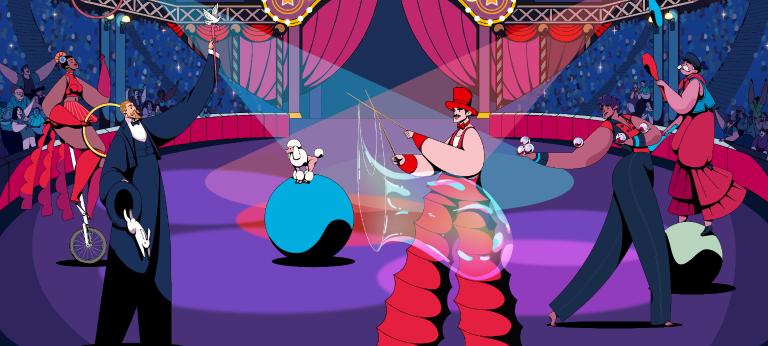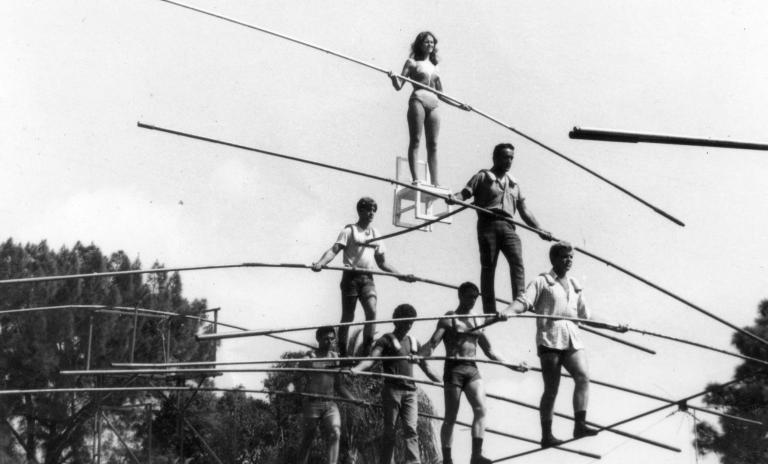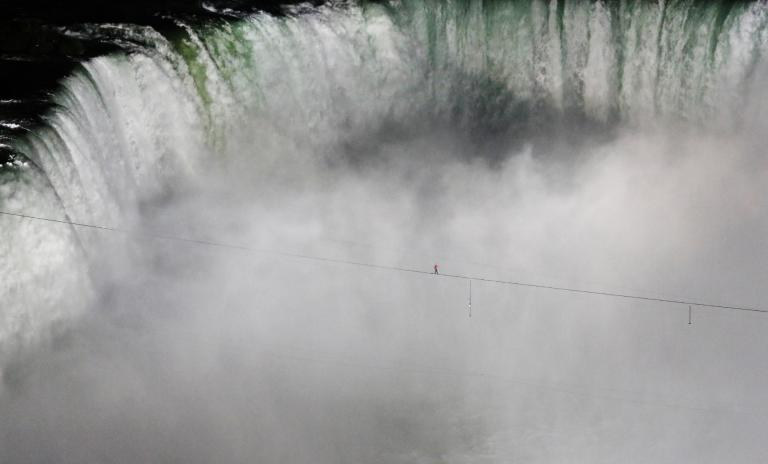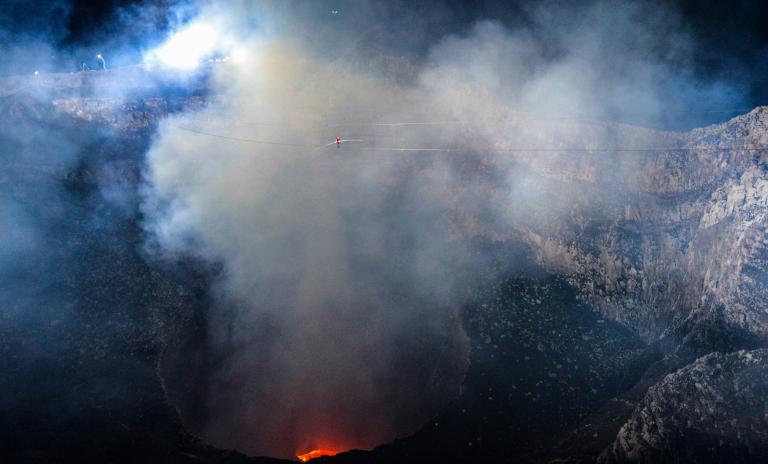The circus of transformation
![{[downloads[language].preview]}](https://www.rolandberger.com/publications/publication_image/ta41_en_cover_download_preview.jpg)
Think:Act Magazine features experts and authors on topics including company reinventions, ethical business, resilience and innovation strategies.



by Bennett Voyles
Personal and business success often hinge on reinventing yourself in the face of adversity. The story of the legendary Flying Wallendas, a family of aerialists and daredevils that have been thrilling audiences for seven generations, makes a case for how training your emotional agility can help carry any endeavor through. It also offers lessons about resilient leadership and team coherence in a risky world.
Seven of the Flying Wallendas were just starting one of their most impressive routines – a slow procession in the shape of a three-story pyramid, high above an audience of 7,000 in Detroit's State Fair Coliseum, with nothing but a 1.9-centimeter wire and a few blue spotlights between the acrobats and the floor. It was January 30, 1962, an ordinary Tuesday night until, suddenly, the lead walker began to lose control of his balancing pole. "I can't hold it any longer," said Dieter Schepp, before he plunged just over 10 meters to the concrete and, as one Shrine Circus clown told a reporter, America's most famous acrobats began to drop from the wire "like coconuts falling from a tree."
Schepp, 23 years old and a Wallenda nephew, died. So did a Wallenda son-in-law. A Wallenda son was paralyzed from the waist down and a cousin suffered a head injury. But the surviving and ambulatory Wallendas somehow climbed back on the high wire the very next night – including Karl Wallenda, the patriarch of the clan, who had to sneak out of the hospital to make the performance.

The following year, the Wallendas even began performing the seven-person pyramid again – and still followed the family tradition of performing without a net. "Vati" Wallenda, a German-born immigrant, said he didn't want people to think of the Wallendas as quitters. He needn't have worried. Despite other serious accidents in the years that followed – including his own fatal fall from a wire strung between two hotel towers in San Juan, Puerto Rico, in 1978 – a seventh generation of Wallendas still make their living on the high wire today, more than 60 years after the accident. "We've lost seven family members doing what we do, but we keep going," said his great-grandson Nik Wallenda in a backstage interview at the Missouri theater where he was performing with the rest of Nik Wallenda's Zirkus in 2023.
How have the Wallendas kept their nerve, despite so many traumatic events, and still keep inventing new acts that enthrall audiences? There seem to be several reasons. In his memoir, Balance: A Story of Faith, Family, and Life on the Line, Nik Wallenda cites his Christianity as a source of strength. It may also stem from the way they were raised. As a scion of an old German-American circus family, Nik more or less grew up in midair. "Walking the wire itself is something that comes very naturally to me … you started walking on the ground at two or less, and I started walking on the wire at that age," he says.
As a psychological matter, however, experts say that resilience comes down to four character traits. Cary Cooper, professor of organizational psychology and health at the Manchester Business School and the co-author of Building Resilience for Success, argues resilience depends entirely on the degree to which you are adaptable, self-confident and able to seek out social support when you need it and maintain a sense of purpose.
Normally, those qualities develop in childhood. However, researchers have found that even if children experienced significant adversity, such as dealing with a learning disability, they can still grow up to be well-adjusted adults. If, that is, they had one "charismatic adult" in their life at some point – someone who truly believed in them, according to Robert Brooks, a Boston-based psychologist and the co-author of The Power of Resilience: Achieving Balance, Confidence, and Personal Strength in your Life.
Despite discouragement from his parents, who feared the industry was dying, Nik eventually overcame their objections and joined his family on the high wire. The turning point came in 1997, when the Hamid-Morton Shrine Circus called his Uncle Tino and asked the Wallendas if they would recreate the seven-person pyramid act in Detroit.
After intense practice, on March 6, 1998, they begin their long walk across the high wire. To keep the pyramid balanced, they move with every teammate's slump and shift "side to side, up and down. We must let them ever-so-slightly bend us without breaking us." In four minutes, as his paralyzed uncle watches from below, Nik and his relatives make it across the wire. With national coverage on CNN and Entertainment Tonight, the Sarasota, Florida, high school senior changes his mind about pursuing a career as a pediatrician and decides to stick with the circus.
The Wallendas seem to have always had gumption to spare, but for the rest of us, the good news is that psychologists say resilience can be trained. Only 5-10% of people "are not very resilient and never will be, given what life has done to them along the way," Cooper says. The rest of us either have it or can develop it. One way to find out where you belong is to take a psychometric assessment that shows you where your weaknesses lie and how they affect your behavior. An experienced psychologist can help you modify those behaviors "in a few sessions over a couple of weeks," says Cooper.
The kind of resilience that holds a group like The Flying Wallendas together, on the other hand, can be tougher to achieve. Even long-standing teams can have a hard time sticking together, let alone making it through demanding transformation journeys. These days, the Wallendas are still up in the air but far less often in the same place. Tino Wallenda leads a 10-person act, while his nephew Nik leads a six-person troupe, the Nik Wallenda Zirkus. "There was never a falling-out on my end," says Nik. "... I just went for big TV stunts and my uncle really focused on circuses."
The elements of team resilience are all the same as with individuals, according to Cooper, with one additional ingredient: "For a team to be resilient, they have to have the right kind of line manager. The manager has to be somebody who has good social, interpersonal skills," he says. And socially skilled managers are in short supply, Cooper adds, not because there aren't socially adept people out there, but because people tend to be promoted for their technical skills and not their social skills.

"I think it's easy to be stuck in a constant cycle of doing the same. And that's why multigenerational businesses fail."
Supportive and encouraging actions matter, according to Brooks, because resilience in an organization depends on the degree to which people feel they are part of the group. Brooks' research found a lot of people's sense of how close they feel to the group depends on little things that others around them did – whether micro-affirmations or micro-aggressions. "It could be a simple comment, it could be a smile," he says. Positive experiences leave a lasting impact too, and particularly when they involved being helpful to the group.
More negatively, an offhand comment can leave an emotional scar. Brooks says that in his workshops about school cultures, for example, people would sometimes burst into tears when they recalled a nasty comment a teacher made to them 40 years ago. However, this too can be overcome through training and introspection. Brooks advises managers begin by trying to cultivate their self-awareness. Ask yourself, for example, how you come across. What words would employees use to describe you? If the answer isn't one you like, try to make some adjustments in what you're doing.
He suggests that to be an empathic manager, it's also important to watch your words. In his own career, he says, he's learned over time about the value of speaking carefully. As a therapist, he found that just focusing on his patients' problems could create a more negative atmosphere. It's important, right from the first meeting, to instead ask them about their strengths, which he dubs their "islands of competence."
Managers need to offer up a few genuine pats on the back too, in Brooks' view, to make employees feel valued and capable of meeting the challenges ahead. "I think if employees are to feel comfortable and part of the organization, it's important for them to know leadership is aware of and acknowledges their strengths," he says.
Despite admiring his great-grandfather's optimism, Wallenda says another emotion has played an important part in his resilience to keep the acts coming: fear. Performing day in and day out – he and his troupe may have three shows a day – means even death-defying feats become routine and it's helpful to be reminded of the danger. "Complacency is what will kill you," he says.
A second fear seems to have been an even more powerful driver for him. As a kid, he remembers being frightened after hearing his parents talk about being nearly broke because of declining circus attendance. In the short run, that fear pushed him to take on all the afterschool work he could find, enabling him to save more than $20,000 by the time he left high school.

Money worries have also shaped his adult career, pushing him to "think outside the Big Top," as he puts it, and to reboot the Wallendas' gravity melodrama for a new century, producing and performing stunts that have put him in front of television audiences on wires across Times Square, Niagara Falls, the Chicago skyline, the Grand Canyon and even a live Nicaraguan volcano. It's also led him to extend the Wallenda brand into other lines of work altogether, such as giving inspirational speeches. "I think it's easy in business to be stuck in a constant cycle of doing the same," he contemplates. "And that's why we see multigenerational businesses fail. Circus World has struggled, because a lot of people in the industry continue to do the same as their parents – or, more often than not, less than their parents did in the industry."
Nik Wallenda sees trying and failing as preferable to the kind of failure that stems from not taking risks: "I think much of society is miserable every day because they're complacent, because they give up on their dreams and settle for the status quo."

![{[downloads[language].preview]}](https://www.rolandberger.com/publications/publication_image/ta41_en_cover_download_preview.jpg)
Think:Act Magazine features experts and authors on topics including company reinventions, ethical business, resilience and innovation strategies.
